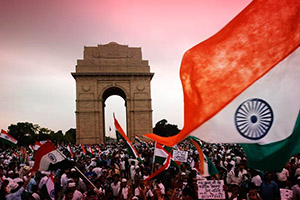
History-Periods
Past eras

From pre-history to today
Choose your period

Periods of History
explore the different eras

The Indian independence movement was a decades-long struggle by the Indian people to end British colonial rule in India. India had been under British rule since the mid-18th century, when the East India Company began to establish trading posts in the country. Over time, the British expanded their control over India, establishing a centralized government and exploiting the country's resources for their own benefit.
The Indian independence movement gained momentum in the early 20th century, with leaders such as Mahatma Gandhi and Jawaharlal Nehru leading campaigns of nonviolent resistance against British rule. The movement was fueled by a growing sense of Indian nationalism, as well as frustration with British policies such as the partition of Bengal and the Rowlatt Acts, which allowed the British government to imprison individuals without trial.
Gandhi became the most prominent figure in the Indian independence movement, advocating for nonviolent civil disobedience as a means of challenging British authority. He organized mass protests, boycotts, and hunger strikes, and encouraged Indians to boycott British goods and services. He also emphasized the importance of self-reliance and self-governance, promoting the idea of swaraj, or Indian self-rule.
The movement gained significant momentum during World War II, as the British government's need for Indian support in the war effort led to increased political negotiations with Indian leaders. In 1942, the Indian National Congress launched the Quit India Movement, calling for the immediate withdrawal of British forces from India. The movement was met with a violent crackdown by the British government, resulting in the imprisonment of thousands of Indian activists.
There were several factors that contributed to the granting of independence to India by the British. One of the most significant factors was the growing independence movement in India, which had been gaining momentum for several decades.
Indian leaders such as Mahatma Gandhi and Jawaharlal Nehru had been leading campaigns of nonviolent resistance against British rule, demanding greater self-rule and autonomy for India. This movement gained significant support from the Indian people, and put increasing pressure on the British government to grant India greater political freedom.
The Second World War also played a role in the granting of independence, as the British government relied on Indian support for the war effort. Indian soldiers fought in large numbers in the war, and India's contribution to the Allied victory was significant. This led to increased political negotiations between the British government and Indian leaders, as the British sought to secure Indian support for the war effort.
Finally, there was growing international pressure on the British to grant India independence. Other European powers were withdrawing from their colonies in Asia and Africa, and there was increasing global opposition to colonialism as a system of government. This international pressure, combined with the domestic pressure from the Indian independence movement, made it increasingly difficult for the British to justify their continued presence in India.
All of these factors contributed to the granting of independence to India in 1947, when the Indian Independence Act was passed by the British Parliament. This act provided for the partition of India into two separate countries, India and Pakistan, and established India as a sovereign nation.
However, the pressure on the British to grant Indian independence continued to mount, and in 1947, the Indian Independence Act was passed by the British Parliament, effectively ending British rule in India. The act provided for the partition of India into two separate states, India and Pakistan, with predominantly Hindu India and predominantly Muslim Pakistan.
The separation of Pakistan from India in 1947 was primarily caused by religious and political tensions between Hindus and Muslims in the region.
The idea of a separate Muslim state had been advocated by the All India Muslim League, a political party that was established in 1906 to represent the interests of Indian Muslims. The Muslim League argued that Muslims in India would not be able to achieve political and social equality under Hindu-majority rule, and called for the creation of a separate Muslim state in the northwestern and northeastern regions of India.
The demand for a separate Muslim state gained significant momentum in the 1940s, with the Muslim League led by Muhammad Ali Jinnah calling for the creation of a separate country called Pakistan. The Indian National Congress, which represented the interests of the Hindu-majority population, opposed the idea of a separate Muslim state, arguing that it would lead to the fragmentation of India and the creation of smaller, weaker states.
Despite these objections, the British government ultimately decided to support the creation of Pakistan, in part to avoid further violence and unrest between Hindus and Muslims. The Indian Independence Act of 1947 provided for the partition of India into two separate countries, with India as a predominantly Hindu state and Pakistan as a predominantly Muslim state.
The partition of India and the creation of Pakistan was accompanied by widespread violence and displacement, with millions of people forced to flee their homes and tens of thousands killed in communal riots. The division of the country also left lasting political and social tensions between India and Pakistan, which have continued to this day.
The partition was accompanied by widespread violence and displacement, with millions of people forced to flee their homes and tens of thousands killed in communal riots. Despite this, India's independence marked a significant moment in the country's history, and the struggle for independence remains an important part of India's national identity.
India became a part of the British Empire through a process of colonization and conquest that began in the mid-18th century. In the early 1600s, the British East India Company established trading posts in India, primarily for the purpose of trading in cotton and silk.
Over time, the East India Company gained more power and influence in India, and by the mid-18th century, it had established a significant military presence in the country. In 1757, the East India Company's army defeated the forces of the Nawab of Bengal at the Battle of Plassey, giving the company control over the wealthy Bengal region.
Over the next several decades, the East India Company continued to expand its control over India through a combination of military conquest and political maneuvering. It established a centralized government in India, with a British-appointed governor-general in charge of the country's affairs.
The British also exploited India's resources for their own benefit, including exporting raw materials such as cotton and tea, and importing finished goods back into India. This led to economic exploitation and inequality, with Indian workers and farmers often being paid low wages for their labor.
By the mid-19th century, India had become a crown colony of the British Empire, meaning that it was directly ruled by the British monarch. This system of colonial rule continued until India gained independence in 1947.
If you have a suggestion regarding additional topics you would like to see included - please let us know
Reference: Article by Greg Scott (Staff Historian), 2024
Tour Reviews
History Attractions
Submit Tour Suggestions
2024 Departures
Spotlight Tours
Events and anniversaries

All content and images are protected by copyright to Access History